
Controlling your energy usage and lowering your electric bill is simple and easy with these handy, effective electric savings tips.
- Change your water heater temperature from 140 degrees to 120 degrees, according to the U.S. Department of Energy, is the recommended temperature setting to save about $2 a month.
2. Install a programmable thermostat to control your cooling tempatures when you are not home. Basic Electric can install one for you.
3. Clean or replace the A/C filter regularly to help your unit run more efficiently and trim cooling costs.
4. Turn off your ceiling fan when you leave the room. A fan that runs all the time costs up to $7 a month.
5. Replace old, high-flow showerheads with water-efficient showerheads and save up to $80 a year.
6. Adjust the water level on your washing machine to match the load size, especially when using hot water. Always use a cold rinse.
7. Clean the lint filter in your dryer before every load to dry your clothes faster.
8. Using the auto sensor function on your dryer to conserve energy by not over-drying your clothes.
9. Cook with something smaller than the oven when possible. When you use a toaster oven, electric skillet, slow cooker or microwave, you use less energy.
10. Run your appliances in the evening. Especially if it’s a brutally hot day. Why? These appliances produce heat, and it will cause your air conditioning to work harder during hot days. It’s better to run your dish washer once it cools down a bit. Or, wash your dishes by hand to save even more.
11. Check your refrigerator and freezer temperature. According to FPL, the ideal refrigerator temperature runs between 37 and 40 degrees, and the ideal freezer reading is 5 degrees. Any colder, and you are wasting money. It’s also important to keep your refrigerator and freezer full so they do not have to work as hard to stay cold.
12. Unplug devices. Computer, television and other devices can drain power even when they are not on.
To see how much energy you are using go to the FPL Energy Analyzer.
Photo by Damir Spanic on Unsplash

